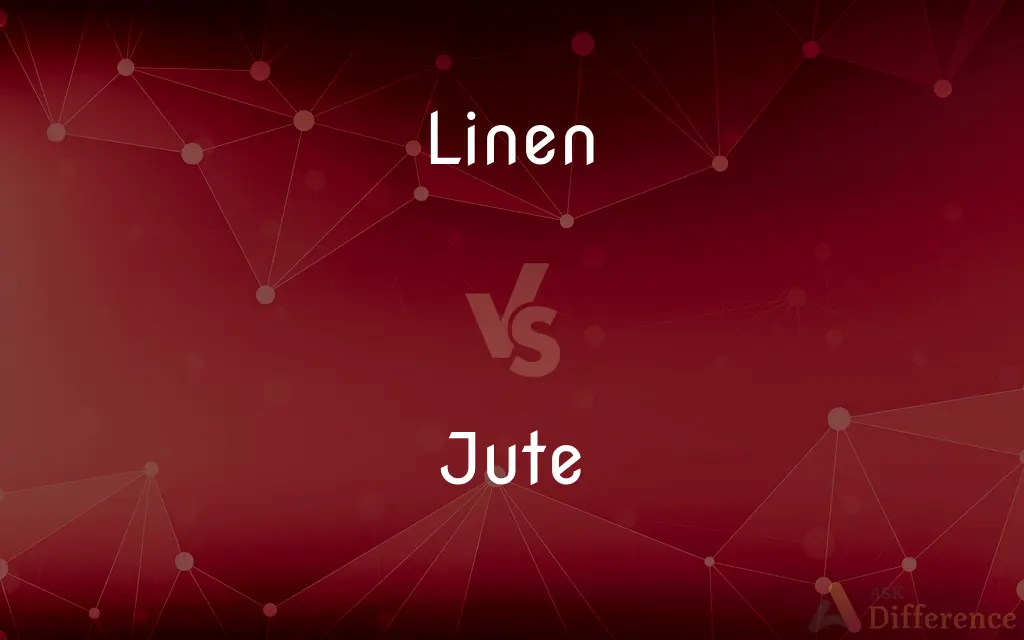Linen vs. Jute — What's the Difference?
By Tayyaba Rehman & Fiza Rafique — Updated on March 8, 2024
Linen is known for its smooth texture and strength, commonly used in high-quality clothing and beddings, whereas jute is rougher and used for burlap, ropes, and sacks.

Difference Between Linen and Jute
Table of Contents
ADVERTISEMENT
Key Differences
Linen, derived from the flax plant, is celebrated for its smoothness, strength, and ability to wick moisture, making it a preferred fabric for clothing and bedding. Its production is labor-intensive, contributing to its higher cost and exclusivity. Jute, on the other hand, comes from the jute plant's stem and is characterized by its coarse texture and high tensile strength, which make it ideal for making burlap, hessian cloth, ropes, and sacks. It is less expensive and more sustainable due to its rapid growth and low environmental impact.
Linen's ability to soften with each wash without losing strength contrasts with jute's durable but less soft nature. Linen garments and textiles are often more expensive and considered luxurious due to their quality and comfort. In contrast, jute products are more economical and serve functional, industrial, and eco-friendly purposes.
Linen's historical use in ancient civilizations as a symbol of light and purity is contrasted by jute's rise to prominence during the Industrial Revolution, where it was valued for its practicality and utility in packaging and transport. Both fibers have rich cultural and historical significances, reflecting their diverse uses and properties.
Despite their differences, both linen and jute play crucial roles in sustainable practices. Linen's cultivation requires fewer pesticides and chemicals than cotton, whereas jute's biodegradability and carbon dioxide assimilation rate contribute positively to environmental sustainability. Their use encourages eco-friendly consumer choices in different sectors.
Comparison Chart
Source
Flax plant
Jute plant
ADVERTISEMENT
Texture
Smooth, softens over time
Coarse, rough
Primary Uses
Clothing, bedding, home décor
Burlap, ropes, sacks, eco-friendly items
Environmental
Less water-intensive, fewer chemicals
Rapidly renewable, biodegradable
Cost
Generally higher, considered luxurious
Lower, economical
Strength & Durability
High strength, durable, softens with washing
High tensile strength, durable but rough
Heat Conductivity
Good, keeps cool
Low, good insulator
Compare with Definitions
Linen
A fabric made from the fibers of the flax plant.
She bought a linen dress for the summer.
Jute
A long, soft, shiny vegetable fiber that can be spun into coarse, strong threads.
They used jute bags for coffee bean transport.
Linen
More expensive due to its labor-intensive production.
The high cost of linen reflects its quality and durability.
Jute
Highly sustainable, with a quick growth cycle.
Jute cultivation is considered eco-friendly due to its low pesticide need.
Linen
Known for its strength and smooth texture.
The linen sheets became softer with each wash.
Jute
Primarily used for burlap, sacks, and hessian cloth.
Jute is often used in agriculture for soil erosion control.
Linen
Ideal for clothing and home textiles.
Linen curtains add a light, airy feel to the room.
Jute
Characterized by its high tensile strength and breathability.
Jute rugs are durable and suitable for high-traffic areas.
Linen
Requires fewer pesticides and less water than cotton.
They chose linen for its environmental benefits.
Jute
More affordable and widely available.
Jute products are popular for their affordability and sustainability.
Linen
Linen () is a textile made from the fibers of the flax plant. Linen is very strong, absorbent, and dries faster than cotton.
Jute
Jute is a long, soft, shiny bast fiber that can be spun into coarse, strong threads. It is produced from flowering plants in the genus Corchorus, which is in the mallow family Malvaceae.
Linen
Cloth woven from flax
A linen suit
He dealt in Irish linens
Jute
A member of a Germanic people that (according to Bede) joined the Angles and Saxons in invading Britain in the 5th century, settling in a region including Kent and the Isle of Wight. They may have come from Jutland.
Linen
Thread made from fibers of the flax plant.
Jute
A member of a Germanic people who invaded Britain in the fifth and sixth centuries AD and settled in the south and southeast and on the Isle of Wight.
Linen
Cloth woven from this thread.
Jute
Either of two Asian plants (Corchorus capsularis or C. olitorius) yielding a fiber used for sacking and cordage.
Linen
Also linens Articles or garments, such as sheets, tablecloths, or underwear, formerly made of linen and now usually made of other fabrics, especially cotton.
Jute
The fiber obtained from these plants.
Linen
Paper made from flax fibers or having a linenlike luster.
Jute
The coarse, strong fiber of the East Indian plants, Corchorus olitorius and Corchorus capsularis, used to make mats, paper, gunny cloth etc.
Linen
Made of flax or linen.
Jute
The plants from which this fibre is obtained.
Linen
Resembling linen.
Jute
The coarse, strong fiber of the East Indian Corchorus olitorius, and Corchorus capsularis; also, the plant itself. The fiber is much used for making mats, gunny cloth, cordage, hangings, paper, etc.
Linen
(uncountable) Thread or cloth made from flax fiber.
Jute
A plant fiber used in making rope or sacks
Linen
(countable) Domestic textiles, such as tablecloths, bedding, towels, underclothes, etc., that are made of linen or linen-like fabrics of cotton or other fibers; linens.
She put the freshly cleaned linens into the linen closet.
Jute
A member of a Germanic people who conquered England and merged with the Angles and Saxons to become Anglo-Saxons
Linen
A light beige colour, like that of linen cloth undyed.
Linen
Made from linen cloth or thread.
Linen
Having the colour linen, light beige.
Linen
Made of linen; as, linen cloth; a linen stocking.
Linen
Resembling linen cloth; white; pale.
Linen
Thread or cloth made of flax or (rarely) of hemp; - used in a general sense to include cambric, shirting, sheeting, towels, tablecloths, etc.; as, bed linens
Linen
Underclothing, esp. the shirt, as being, in former times, chiefly made of linen.
Linen
A fabric woven with fibers from the flax plant
Linen
A high-quality paper made of linen fibers or with a linen finish
Linen
White goods or clothing made with linen cloth
Common Curiosities
What is linen made from?
Linen is made from the fibers of the flax plant.
Why is linen considered luxurious?
Due to its smooth texture, strength, and labor-intensive production process.
Can linen be washed?
Yes, linen can be washed and becomes softer with each wash.
Is jute durable?
Yes, jute is durable with high tensile strength.
How does the cost of linen compare to jute?
Linen is generally more expensive than jute due to its quality and production costs.
Can both linen and jute be used in home décor?
Yes, both are used in home décor, linen for its aesthetic appeal and jute for its natural look.
What are the main uses of jute?
Jute is mainly used for making burlap, ropes, sacks, and eco-friendly items.
Is linen good for summer clothing?
Yes, its breathable nature and ability to wick moisture make it ideal for summer.
Why is jute considered eco-friendly?
Because it is biodegradable, requires little to no pesticides, and has a quick growth cycle.
Are there any environmental benefits to using linen over cotton?
Yes, linen requires less water and fewer chemicals to produce than cotton.
What historical significance does linen have?
Linen has been used since ancient times, symbolizing purity and light.
What differentiates the texture of linen and jute?
Linen is smooth and softens over time, while jute is coarse and remains rough.
How did jute gain prominence?
Jute gained prominence during the Industrial Revolution for its practicality in packaging and transport.
Can jute be used in agriculture?
Yes, jute is used for soil erosion control and as a natural fiber in agro-based products.
How does jute contribute to environmental sustainability?
Jute absorbs CO2 faster than many trees and is fully biodegradable.
Share Your Discovery

Previous Comparison
Cigar vs. Cigarette
Next Comparison
Bushing vs. GrommetAuthor Spotlight
Written by
Tayyaba RehmanTayyaba Rehman is a distinguished writer, currently serving as a primary contributor to askdifference.com. As a researcher in semantics and etymology, Tayyaba's passion for the complexity of languages and their distinctions has found a perfect home on the platform. Tayyaba delves into the intricacies of language, distinguishing between commonly confused words and phrases, thereby providing clarity for readers worldwide.
Co-written by
Fiza RafiqueFiza Rafique is a skilled content writer at AskDifference.com, where she meticulously refines and enhances written pieces. Drawing from her vast editorial expertise, Fiza ensures clarity, accuracy, and precision in every article. Passionate about language, she continually seeks to elevate the quality of content for readers worldwide.
















































